|
Prior to the advent of commonplace
high-speed digital computers, designing advanced aircraft structures required a
lot of effort building scale models and testing them in wind tunnels and, when possible,
in actual flight. The process was both expensive and time-consuming. As computer
simulations have been fine tuned, the need to build models have been nearly entirely
eliminated. Modern aircraft can go from computer monitor to production with the
full-size prototype being the first actual version of the plane to be built. This
article from a 1957 issue of American Modeler magazine reports on some
of the very labor-intensive experimental and scale models built for testing and
concept verification. Many of the technicians who did the planning and building
were hobbyists who were fortunate enough to gets jobs to get paid for engaging in
their passion. Although only model aircraft are covered here, the same was needed
for trains, cars, trucks, boats, and other vehicles.
Model Making Offers Money Making Opportunities
By Tom StanberryEngineering Write, Convair (San-Diego)
Division of General Dynamics Corporation
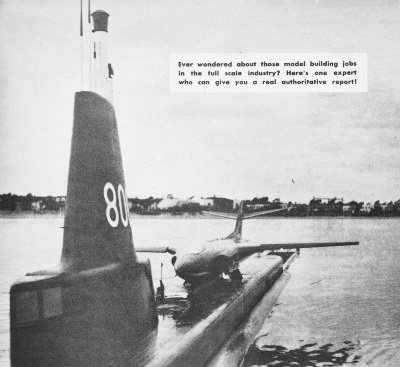 Ever wondered about those model building jobs
in the full scale industry? Here's one expert who can give you a real authoritative
report ! Ever wondered about those model building jobs
in the full scale industry? Here's one expert who can give you a real authoritative
report !
If you're a model builder and if you're between the ages of six and 60 - why
not turn your hobby into a career?
The growth of industrial uses for all type of models, especially in the aircraft
field, now makes it possible for hobbyists to expand their activities into well
paying, career opportunities.
In the aircraft industry models are used for many, diversified purposes. Wind
tunnel models are used for aerodynamic studies, break-away models are used for planning,
or they can be used for display purposes and classroom training. Models also can
be photographed and used to illustrate brochures for presentations in sales campaigns.
Another growing use for model techniques is in the visual aids now in constant
demand to illustrate complex aircraft components and systems. They also have played
an important part in crash investigations, and are widely used as scale flight models
to be flown off land or water using radio control to study actual flight characteristics.
Many more uses are being found or forseen for models in the aircraft industry.
They are being used to animate movies of simulated missile flights that are startlingly
realistic.
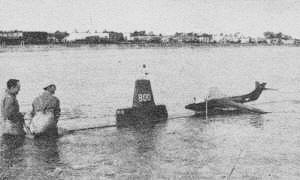
Scale models of a submarine and jet seaplane were built to evaluate
the production possibilities of the proposed airplane. Seaplane model is radio controlled
and powered by small jet engines.
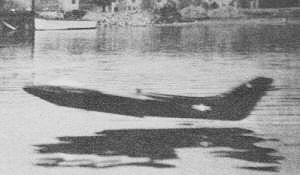
Flying model of jet seaplane takes off. By using models, aircraft
industry duplicates actual operational conditions long before aircraft is in production.
Crewmen show relative sizes.
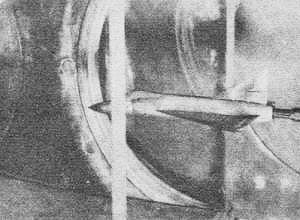
Detailed model of Convair's F-102A shown in wind tunnel. Important
aerodynamic data is accumulated long before the big plane is actually built.
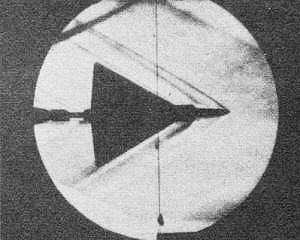
Schlieren
photo shows the airflow and shock waves.
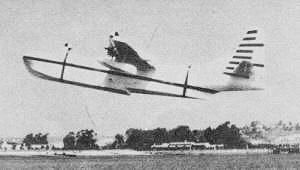
Flying radio control models is a very important feature of conducting
hydrodynamic studies on a new model flying boat. Take-off time. handling, and spray
problems can be determined.
Never before has the practicability of models been better appreciated and utilized
by industry. But it must be remembered, industrial model building is conducted on
a high professional level and is a type not usually found in the hobby field. The
work is exacting and demands top craftsmanship.
R. W. Seehorn, supervisor of the model shop and visual training aids section
of Convair's engineering department in San Diego, had this to say about the type
of experience that is desired in industrial model makers.
"There is about the same degree of difference between hobby model making and
industrial model making as there is between commercial art and the fine arts."
Seehorn also pointed out that the time element in industrial model making is
an item. Deadlines make it necessary that mass production type work be done, but
the standards are, nevertheless, very high. The builder who spends painstaking hours
in producing a mirror-like finish on a wing or fuselage would probably find it difficult
maintaining work schedules.
A youngster who commences his model building early, and also develops a few specialized
skills along with his growth should have no difficulty moving into professional
ranks.
These specialized skills can be developed right along with regular classwork
in grade and high schools. Shop courses in wood or metal working are very valuable.
The ability to use a lathe, band saw, drill press, jointer, and hand tools is a
necessary part of model making. Blueprint reading and drafting ability are two more
desirable assets. If possible it would be advisable to study commercial art because
a lot of model makers graduate from the drawing board to model making and the two
fields are closely allied.
In addition today's professional model builder must possess a lot of knowledge
in many other fields. He must be acquainted with plastics, plaster mold making,
adhesives, layout, spray painting, silk-screening of decals, sand mold making, techniques
of silver soldering, and how to use glass cloth. Knowing the procedures involved
in cutting, forming, and dying of plexiglass and plastics is useful. Any experience
that can be gained in miniature model making also would be handy but not absolutely
necessary.
All of which may sound rather formidable but these requirements are abilities
most talented model builders already possess to a limited extent. All that needs
to be done is to develop and expand these assets.
Models played an important part in detecting causes for several recent airplane
crashes. Their use greatly aided the extensive research that delved into the mysterious
crashes of Britain's first Comet airliners. Another accident investigation saw models
being used to duplicate a plane's attitude in the air just before it disintegrated.
This made it possible to ascertain just when the airplane started to break up and
was of value in determining reasons why.
Salaries are dependent, of course, upon experience and training but are generally
comparable to those earned by commercial artists, which range in the aviation industry
from 300 to over 600 dollars monthly.
So, if you can fill the outlined requirements and would like to make it pay,
give serious thought to the career possibilities offered for your model making hobby.
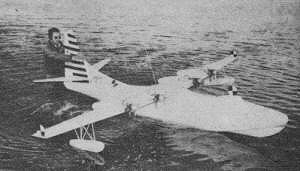
Crewman holds down a model seaplane as the engines are revved
up prior to flight. Notice the whip antenna protruding from the fuselage of the
R/C job. Markings aid motion picture studies.
Posted December 30, 2021
(updated from original post on 7/11/2012)
|


